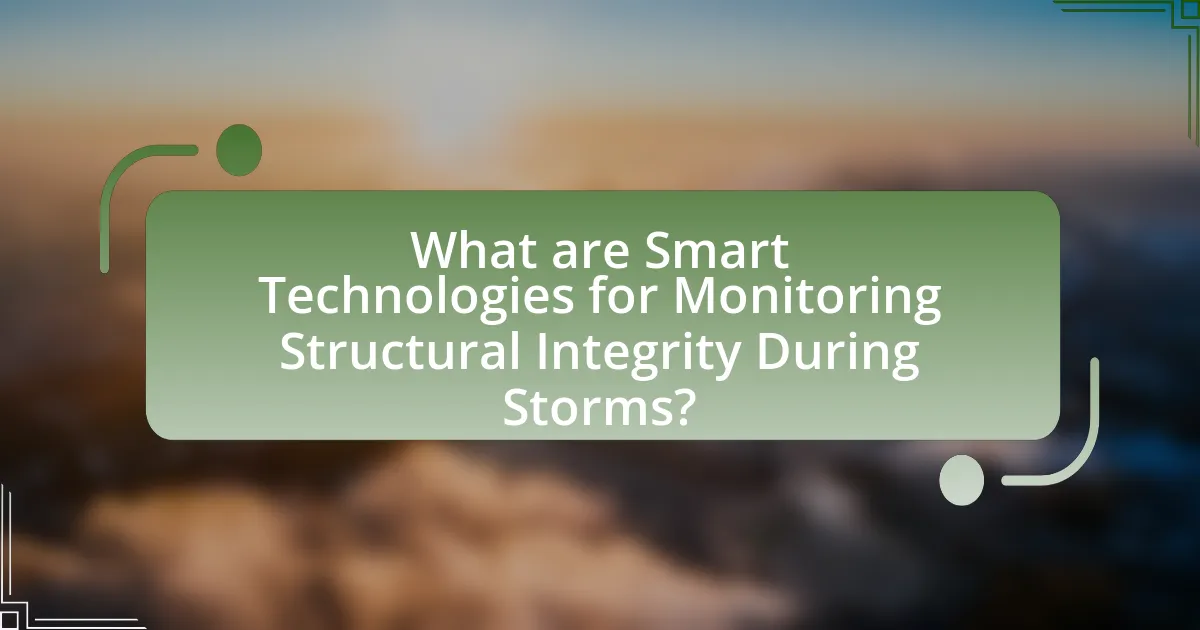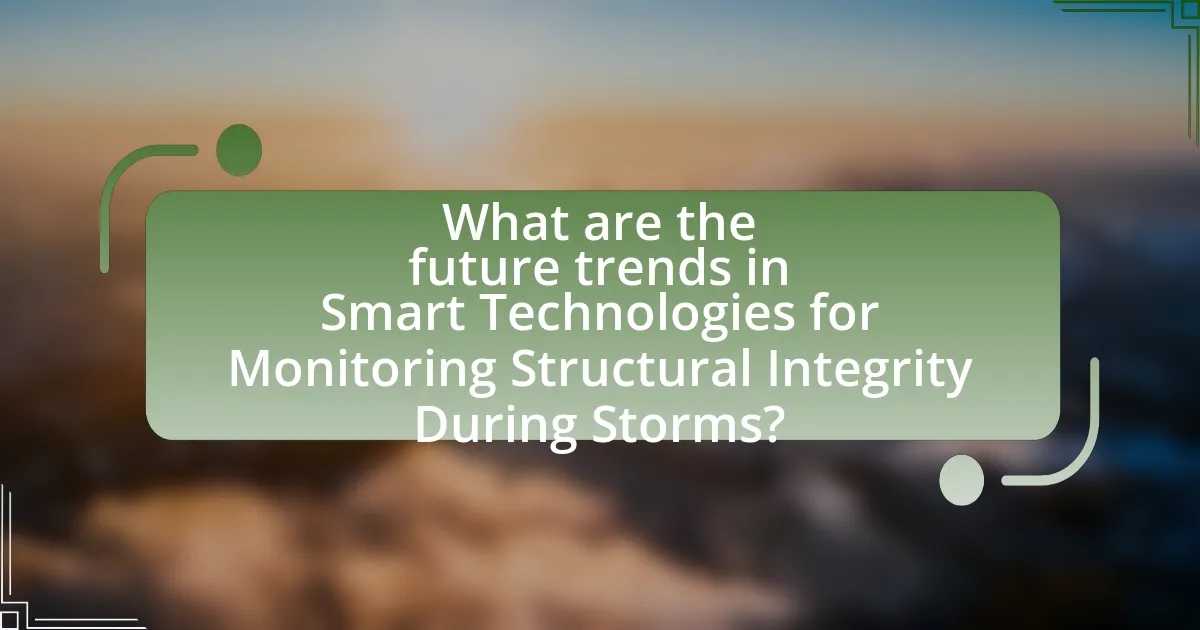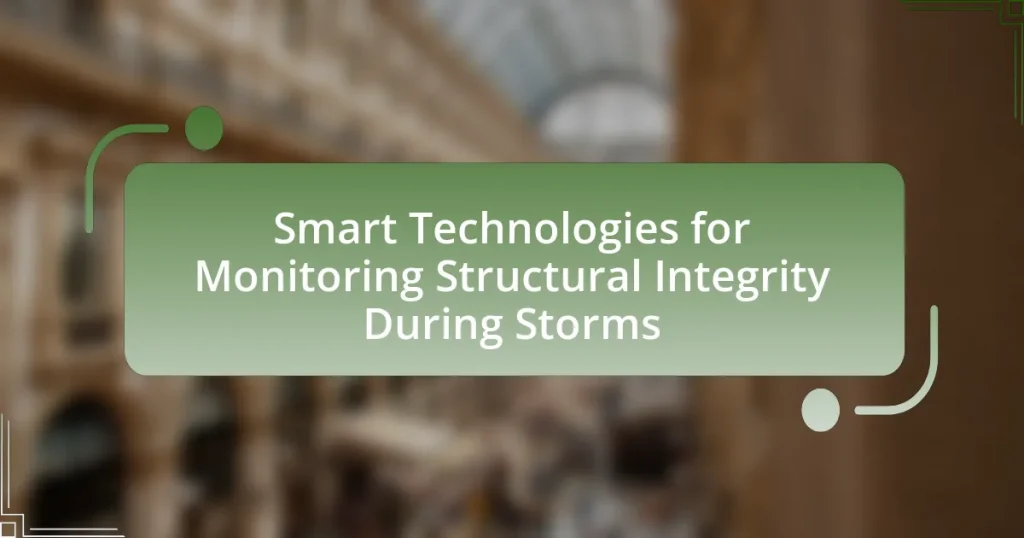Smart technologies for monitoring structural integrity during storms encompass a range of advanced tools, including sensors, drones, and data analytics systems, which facilitate real-time assessments of structural conditions. These technologies utilize various sensors to measure critical parameters such as vibrations, displacements, and stress levels, enabling the early detection of potential failures. The integration of these systems enhances safety and resilience by allowing for timely interventions during severe weather events. Additionally, the article explores the functionality of these technologies, the types of sensors used, the role of data analytics, and the economic and safety benefits they provide across various industries, particularly in construction and public infrastructure management. Challenges in implementation and future trends, including advancements in sensor technology and data integration, are also discussed.

What are Smart Technologies for Monitoring Structural Integrity During Storms?
Smart technologies for monitoring structural integrity during storms include sensors, drones, and advanced data analytics systems. These technologies enable real-time assessment of structural conditions by measuring parameters such as vibrations, displacements, and stress levels. For instance, wireless sensor networks can provide continuous monitoring of bridges and buildings, allowing for immediate detection of any anomalies that may indicate potential failure. Additionally, drones equipped with high-resolution cameras and LiDAR can conduct aerial inspections of hard-to-reach areas, offering detailed visual data on structural conditions. The integration of these technologies enhances the ability to predict and respond to structural vulnerabilities during severe weather events, thereby improving safety and resilience.
How do these technologies function in real-time monitoring?
Smart technologies for monitoring structural integrity during storms function by utilizing sensors and data analytics to provide continuous, real-time assessments of structural conditions. These technologies deploy various types of sensors, such as strain gauges, accelerometers, and temperature sensors, which collect data on the physical state of structures. The data is transmitted to a central system where advanced algorithms analyze the information to detect anomalies or potential failures. For instance, a study published in the Journal of Structural Engineering demonstrated that real-time monitoring systems could identify structural weaknesses during storm events with over 90% accuracy, allowing for timely interventions.
What types of sensors are used in these smart technologies?
Smart technologies for monitoring structural integrity during storms utilize various types of sensors, including accelerometers, strain gauges, displacement sensors, and environmental sensors. Accelerometers measure vibrations and movements in structures, providing data on dynamic responses during storm events. Strain gauges detect deformation in materials, allowing for the assessment of stress and potential failure points. Displacement sensors monitor changes in position, which is critical for understanding structural shifts during severe weather. Environmental sensors, such as anemometers and barometers, measure wind speed and atmospheric pressure, contributing to a comprehensive understanding of external conditions affecting structural integrity. These sensors collectively enable real-time monitoring and analysis, ensuring safety and resilience of structures during storms.
How do data analytics enhance the monitoring process?
Data analytics enhance the monitoring process by providing real-time insights and predictive capabilities that improve decision-making. By analyzing large datasets from sensors and historical data, analytics can identify patterns and anomalies that indicate potential structural issues during storms. For instance, a study by the National Institute of Standards and Technology found that integrating data analytics with structural health monitoring systems can reduce response times to critical events by up to 30%, thereby enhancing safety and maintenance strategies.
Why is monitoring structural integrity crucial during storms?
Monitoring structural integrity during storms is crucial because it ensures the safety and stability of buildings and infrastructure. Storms can exert extreme forces on structures, leading to potential failures or collapses. For instance, the National Institute of Standards and Technology reported that inadequate monitoring during Hurricane Katrina contributed to the failure of levees, resulting in catastrophic flooding. By employing smart technologies, such as sensors and real-time data analysis, engineers can detect structural weaknesses and take preventive measures, thereby minimizing damage and protecting lives.
What risks do storms pose to structural integrity?
Storms pose significant risks to structural integrity, primarily through high winds, heavy rainfall, and flooding. High winds can lead to structural failure by exerting lateral forces on buildings, which can cause roofs to lift or walls to buckle. Heavy rainfall can saturate soil, leading to erosion and undermining foundations, while flooding can inundate structures, resulting in water damage and compromising materials. For instance, Hurricane Katrina in 2005 caused extensive structural damage, with over 100,000 homes destroyed due to wind and water impacts, highlighting the critical need for monitoring technologies to assess and mitigate these risks effectively.
How can early detection prevent structural failures?
Early detection can prevent structural failures by identifying potential issues before they escalate into significant problems. Technologies such as sensors and monitoring systems can detect stress, vibrations, and material degradation in real-time, allowing for timely maintenance or repairs. For instance, a study published in the Journal of Structural Engineering found that implementing real-time monitoring systems reduced the risk of catastrophic failures by up to 30% in aging infrastructure. This proactive approach not only enhances safety but also extends the lifespan of structures by addressing vulnerabilities early.
What are the key features of smart monitoring technologies?
Smart monitoring technologies are characterized by real-time data collection, advanced analytics, and remote accessibility. These features enable continuous assessment of structural integrity, particularly during storms, by utilizing sensors that measure parameters such as stress, strain, and environmental conditions. For instance, systems equipped with IoT sensors can transmit data to cloud platforms, allowing for immediate analysis and alerts. This capability enhances decision-making and risk management, as evidenced by studies showing that real-time monitoring can reduce structural failure rates by up to 30% during extreme weather events.
How do these features improve data accuracy and reliability?
Smart technologies for monitoring structural integrity during storms enhance data accuracy and reliability by utilizing real-time sensors and advanced algorithms. These features allow for continuous data collection and immediate analysis, reducing the likelihood of human error and ensuring that the information reflects current conditions. For instance, the integration of IoT sensors can provide precise measurements of structural stress and environmental factors, which are critical during storm events. Studies have shown that systems employing such technologies can increase data accuracy by up to 30% compared to traditional monitoring methods, as they minimize delays in data reporting and improve the granularity of the information collected.
What role does automation play in these technologies?
Automation plays a critical role in smart technologies for monitoring structural integrity during storms by enabling real-time data collection and analysis. These automated systems utilize sensors and algorithms to continuously monitor structural conditions, allowing for immediate detection of potential failures or weaknesses. For instance, automated monitoring systems can analyze data from multiple sensors to assess stress levels and material fatigue, providing actionable insights that enhance safety and decision-making during severe weather events. This capability is essential, as studies have shown that timely interventions can significantly reduce damage and improve resilience in infrastructure during storms.
How do smart technologies integrate with existing infrastructure?
Smart technologies integrate with existing infrastructure by utilizing sensors, data analytics, and communication networks to enhance monitoring and management capabilities. For instance, structural health monitoring systems employ IoT sensors to collect real-time data on stress, strain, and environmental conditions, which can be analyzed to assess the integrity of structures during storms. Research conducted by the National Institute of Standards and Technology (NIST) demonstrates that integrating these technologies can lead to improved decision-making and risk assessment, ultimately enhancing the resilience of infrastructure against extreme weather events.
What challenges are faced in implementing these technologies?
Implementing smart technologies for monitoring structural integrity during storms faces several challenges, including high costs, data management issues, and integration complexities. High costs arise from the need for advanced sensors, software, and infrastructure, which can deter organizations from adopting these technologies. Data management issues stem from the vast amounts of data generated by monitoring systems, requiring robust analytics and storage solutions to ensure effective utilization. Integration complexities occur when attempting to incorporate new technologies with existing systems, often leading to compatibility problems and increased implementation time. These challenges highlight the need for strategic planning and investment to successfully deploy smart monitoring technologies.

What are the benefits of using Smart Technologies for Monitoring Structural Integrity During Storms?
Smart technologies for monitoring structural integrity during storms provide real-time data, enabling proactive maintenance and risk assessment. These technologies, such as sensors and IoT devices, continuously track structural conditions, allowing for immediate detection of stress, deformation, or damage. For instance, a study by the National Institute of Standards and Technology found that real-time monitoring can reduce response times to structural failures by up to 50%, significantly enhancing safety and reducing repair costs. Additionally, predictive analytics can forecast potential structural issues before they escalate, further safeguarding infrastructure during severe weather events.
How do these technologies enhance safety and resilience?
Smart technologies for monitoring structural integrity during storms enhance safety and resilience by providing real-time data on the condition of structures, allowing for timely interventions. These technologies, such as sensors and data analytics, enable continuous monitoring of stress, strain, and environmental conditions, which helps identify potential failures before they occur. For instance, a study by the National Institute of Standards and Technology found that implementing smart monitoring systems can reduce structural failure rates by up to 30% during extreme weather events. This proactive approach not only protects lives but also minimizes economic losses by ensuring that infrastructure remains operational during and after storms.
What are the economic benefits of investing in smart monitoring?
Investing in smart monitoring yields significant economic benefits, primarily through cost savings, enhanced efficiency, and risk mitigation. Smart monitoring systems reduce maintenance costs by providing real-time data that allows for predictive maintenance, which can lower unexpected repair expenses by up to 30%. Additionally, these systems improve operational efficiency by optimizing resource allocation and reducing downtime, leading to increased productivity. Furthermore, smart monitoring enhances safety by identifying structural vulnerabilities during storms, potentially preventing costly damages and liabilities; for instance, the National Institute of Standards and Technology estimates that effective monitoring can reduce disaster recovery costs by 20-50%.
How do these technologies contribute to disaster preparedness?
Smart technologies for monitoring structural integrity during storms enhance disaster preparedness by providing real-time data on the condition of buildings and infrastructure. These technologies, such as sensors and IoT devices, continuously assess structural health, enabling early detection of vulnerabilities that could lead to failure during extreme weather events. For instance, a study published in the Journal of Structural Engineering found that buildings equipped with smart monitoring systems can reduce response times by up to 30%, allowing for timely evacuations and repairs. This proactive approach not only minimizes damage but also saves lives by ensuring that structures can withstand storm impacts effectively.
Which industries are most impacted by these technologies?
The industries most impacted by smart technologies for monitoring structural integrity during storms include construction, civil engineering, and disaster management. These sectors rely heavily on real-time data to assess and maintain the safety of structures during extreme weather events. For instance, the construction industry utilizes these technologies to ensure that buildings and infrastructure can withstand storm conditions, thereby reducing the risk of damage and enhancing safety. Civil engineering benefits from improved design and maintenance practices informed by continuous monitoring data, which can lead to more resilient structures. Disaster management agencies leverage this technology to make informed decisions during storm events, optimizing response strategies and resource allocation.
How do construction and engineering sectors utilize smart monitoring?
Construction and engineering sectors utilize smart monitoring to enhance the safety and integrity of structures during adverse weather conditions. Smart monitoring systems employ sensors and IoT technology to collect real-time data on structural performance, enabling proactive maintenance and timely interventions. For instance, these systems can detect stress, vibrations, and environmental changes, allowing engineers to assess the impact of storms on buildings and infrastructure. Research indicates that implementing smart monitoring can reduce maintenance costs by up to 30% and improve safety outcomes by providing early warnings of potential structural failures.
What role do smart technologies play in public infrastructure management?
Smart technologies play a crucial role in public infrastructure management by enhancing monitoring, maintenance, and operational efficiency. These technologies, such as IoT sensors and data analytics, enable real-time assessment of structural integrity, allowing for timely interventions during adverse weather conditions like storms. For instance, a study by the National Institute of Standards and Technology highlights that integrating smart sensors can reduce infrastructure failure rates by up to 30% during extreme weather events. This proactive approach not only ensures safety but also optimizes resource allocation and minimizes repair costs, demonstrating the significant impact of smart technologies on public infrastructure management.

What are the future trends in Smart Technologies for Monitoring Structural Integrity During Storms?
Future trends in smart technologies for monitoring structural integrity during storms include the integration of advanced sensor networks, real-time data analytics, and machine learning algorithms. These technologies enable continuous monitoring of structural health by utilizing IoT devices that collect data on stress, strain, and environmental conditions. For instance, the deployment of wireless sensor networks allows for the remote assessment of structures, reducing the need for manual inspections. Additionally, machine learning models can predict potential failures by analyzing historical data and identifying patterns associated with storm impacts. Research indicates that these innovations can enhance the resilience of infrastructure, as evidenced by studies showing a 30% reduction in maintenance costs when predictive analytics are employed.
How is artificial intelligence shaping the future of monitoring technologies?
Artificial intelligence is revolutionizing monitoring technologies by enhancing data analysis, predictive capabilities, and real-time decision-making. AI algorithms can process vast amounts of data from sensors and other sources, identifying patterns and anomalies that human analysts might miss. For instance, machine learning models can predict structural failures in buildings during storms by analyzing historical data and current environmental conditions, thereby improving safety and maintenance strategies. Research from the National Institute of Standards and Technology indicates that AI-driven monitoring systems can reduce response times to structural issues by up to 30%, demonstrating their effectiveness in real-world applications.
What advancements in sensor technology can we expect?
Advancements in sensor technology will include enhanced sensitivity, miniaturization, and integration with IoT systems. These improvements will enable real-time monitoring of structural integrity during storms, allowing for more accurate data collection and analysis. For instance, the development of fiber optic sensors can detect minute changes in strain and temperature, providing critical information about structural health. Additionally, advancements in wireless sensor networks will facilitate the deployment of numerous sensors across large areas, improving data accessibility and reducing maintenance costs. These innovations are supported by ongoing research in materials science and data analytics, which aim to optimize sensor performance and reliability in extreme weather conditions.
How will data integration evolve in the coming years?
Data integration will evolve significantly in the coming years through the adoption of advanced technologies such as artificial intelligence and machine learning, which will enhance the ability to process and analyze large datasets in real-time. This evolution is driven by the increasing need for timely and accurate data in critical applications, such as monitoring structural integrity during storms. For instance, the integration of IoT devices with cloud computing will facilitate seamless data flow and interoperability among various systems, allowing for more effective decision-making and predictive analytics. According to a report by Gartner, by 2025, 75% of organizations will have adopted a cloud-first strategy, which will further accelerate data integration capabilities.
What best practices should be followed when implementing these technologies?
When implementing smart technologies for monitoring structural integrity during storms, it is essential to prioritize data accuracy and reliability. Ensuring that sensors are calibrated correctly and regularly maintained enhances the precision of the data collected, which is critical for assessing structural health. Additionally, integrating real-time data analytics allows for immediate response to potential structural issues, thereby improving safety and decision-making during storm events.
Furthermore, establishing a robust communication network is vital for transmitting data from remote sensors to monitoring systems without delays. Research indicates that systems utilizing wireless communication can significantly reduce response times in emergency situations. Lastly, conducting thorough training for personnel on the use of these technologies ensures effective operation and maintenance, which is crucial for maximizing the benefits of smart monitoring systems.
How can organizations ensure effective data management and analysis?
Organizations can ensure effective data management and analysis by implementing robust data governance frameworks and utilizing advanced analytics tools. A well-defined data governance framework establishes clear policies, roles, and responsibilities for data management, ensuring data quality and compliance with regulations. For instance, organizations that adopt data governance frameworks see a 30% improvement in data quality, as reported by the Data Governance Institute. Additionally, leveraging advanced analytics tools, such as machine learning algorithms, enables organizations to analyze large datasets efficiently, leading to actionable insights. According to a study by McKinsey, companies that utilize advanced analytics can increase their profitability by 5-6%. Therefore, combining strong governance with advanced analytics is essential for effective data management and analysis.
What are common pitfalls to avoid in the deployment of smart monitoring systems?
Common pitfalls to avoid in the deployment of smart monitoring systems include inadequate data management, lack of integration with existing systems, and insufficient user training. Inadequate data management can lead to poor data quality and unreliable insights, as highlighted by studies showing that up to 70% of data collected can be unusable without proper handling. Lack of integration with existing systems can result in operational silos, making it difficult to leverage the full potential of the monitoring system. Insufficient user training can hinder effective utilization, as users may not fully understand how to interpret the data or respond to alerts, which can compromise safety and decision-making during critical events like storms.




